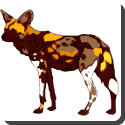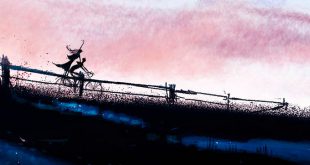 African Hunting Dog — The African Wild Dog or African Hunting Dog, Lycaon pictus, is a carnivorous mammal of the Canidae family, found only in Africa, especially in scrub savanna and other lightly wooded areas. It is also called Cape Hunting Dog, Painted Dog, or Painted Wolf in English, Wildehond in Afrikaans, and Mbwa mwitu in Swahili. It is the only species in the monotypic genus, Lycaon.
African Hunting Dog — The African Wild Dog or African Hunting Dog, Lycaon pictus, is a carnivorous mammal of the Canidae family, found only in Africa, especially in scrub savanna and other lightly wooded areas. It is also called Cape Hunting Dog, Painted Dog, or Painted Wolf in English, Wildehond in Afrikaans, and Mbwa mwitu in Swahili. It is the only species in the monotypic genus, Lycaon.
Adults typically weigh 17-36 kilograms (37-79 pounds). A tall, lean animal, they stand about 30 inches (75 cm) at the shoulder, with a head and body length averaging about 40 inches (100cm) and a tail of 12 to 18 inches (30-45cm). Animals in southern Africa are generally larger than those in the eastern or western Africa.
Wild dogs reproduce at any time of year and peak between March and June during the second half of the rainy season. 2-19 pups can be born per litter, though 10 is the most usual number. The time between births is usually 12-14 months, though it can also be as short as 6 months if all of the previous young die. Pups are usually born in an abandoned den dug by other animals such as aardvarks. Weaning takes place at about 10 weeks. After 3 months, the den is abandoned and the pups begin to run with the pack. At the age of 8-11 months they can kill small prey, but they are not proficient until about 12-14 months, at which time they can fend for themselves. Pups reach sexual maturity at the age of 12-18 months.
African Wild Dogs hunt in packs. Their main prey varies among populations, but always focuses on medium sized ungulates such as impala. A few packs, however, will also include much larger animals, such as wildebeests and zebras, in their prey. This requires a closely coordinated attack, beginning with a rapid charge to stampede the herd. One wild dog then grabs the victim’s tail, while another attacks the upper lip, and the remainder disembowel the animal while it is immobilised. This behaviour is also used on other large dangerous prey such as warthogs, cape buffalo and giraffe calves and large antelope-even the 1 ton Giant Eland. Though it sounds brutal this method actually kills large animals far more quickly than the strangle hold used by big cats,which can take 10 minutes or more to kill. Remarkably, this appears to be a learned tactic, passed on from generation to generation within specific hunting packs, rather than an instinctive behaviour found commonly within the species. Some studies have also shown that other information, such as the location of watering holes, may be passed on in a similar fashion. While the vast majority of their diet is made up of mammal prey they do sometimes hunt large birds,especially ostrich’s.
 Kids Portal For Parents India Kids Network
Kids Portal For Parents India Kids Network






